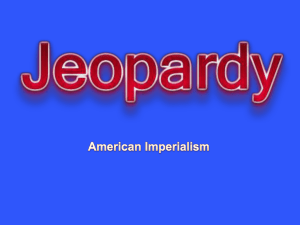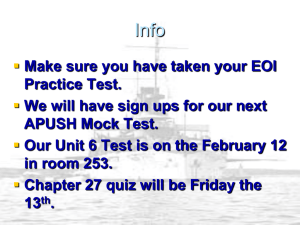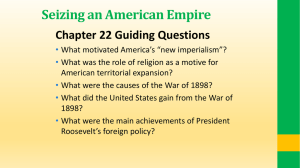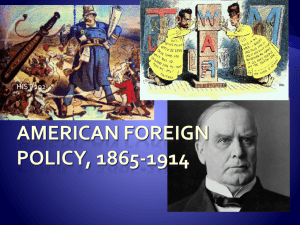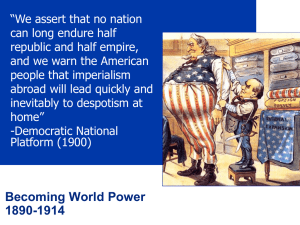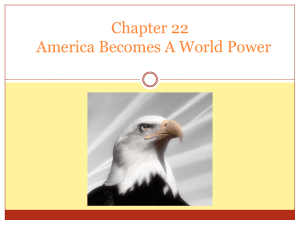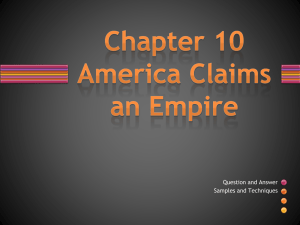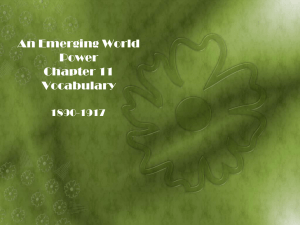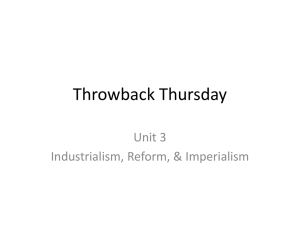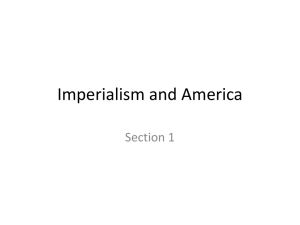henretta3e_ch21
advertisement
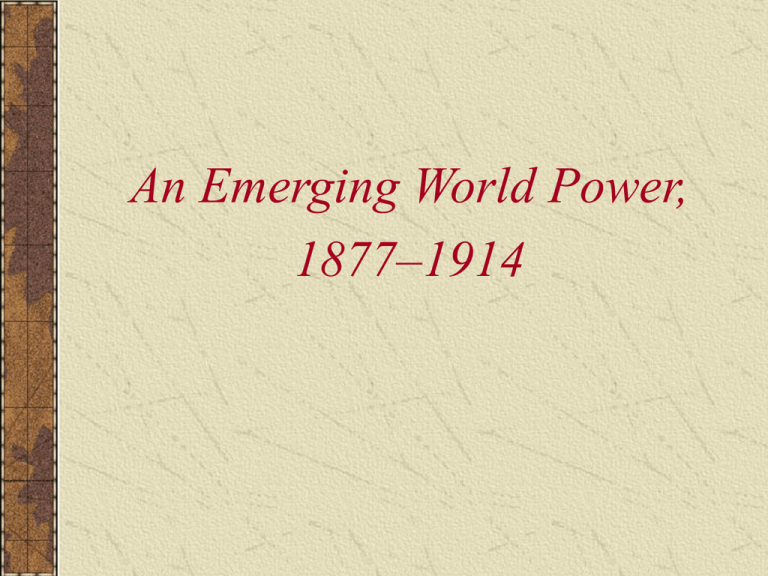
An Emerging World Power, 1877–1914 1. How economic interests affected American involvement in overseas expansion? 2. The causes and consequences of the SpanishAmerican War? 3. Why and how President Wilson’s attempted to reconcile America’s foreign policy with the nation’s political ideals. 4. How American foreign policy developed between 1877 and 1914. The Roots of Expansion Diplomacy in the Gilded Age The Economy of Expansionism The Making of a “Large” Foreign Policy The Ideology of Expansionism Diplomacy in the Gilded Age In 1880 the United States had a population of 50 million, and the nation's industrial production ranked second only to Britain's. The Civil War had put the United States at odds with Britain and France. The United States opposed France's attempt to establish a puppet regime in Mexico and, with Britain, the issues involved damages to Union shipping by the Alabama and other Confederate sea raiders operating from English ports. In the years after the Civil War, the United States lapsed into diplomatic inactivity as the building of the nation's industrial economy turned Americans' attention inward. Americans shared a sense of security and isolation from the rest of the world, even though new international telegraphic cables provided overseas communication after the 1860s. The U.S. Navy fleet gradually deteriorated; the administration of Chester A. Arthur (1881-1885) began a modest upgrading program, but the navy remained small. Domestic politics made it difficult to develop a coherent foreign policy, and appointment to the foreign service was mostly through the spoils system. The State Department tended to be inactive and exerted little control over either policy or its missions abroad; the American presence often consisted of independent religious missionaries. The expansionist enthusiasms of the Civil War era subsided in the Caribbean and, despite its claims of exclusive rights, the United States stood by when a French company started to dig across the Panama isthmus in 1880. Diplomatic activity quickened when James G. Blaine became secretary of state in 1881; he tried his hand at settling disputes in South America, and he called the first Pan American conference. His successor canceled the conference, an act that was a characteristic example of Gilded Age diplomacy, driven largely by partisan politics and carried out without any clear sense of national purpose. Pan-American ism-the notion of a community of Western-Hemispheric states-took root. When Blaine returned in 1889 for a second stint at the State Department, he approved plans for another PanAmerican conference. Nothing came of the conference, though the Pan-American Union was founded, and any South American goodwill was blasted by the humiliation the United States visited on Chile because of a riot against American sailors in the port of Valparaiso in 1891. In the Pacific, American interest centered on Hawaii. where sugarcane had attracted American planters and investors; an 1875 treaty had given Hawaiian sugar duty-free entry into the American market and declared the islands off limits to other powers After the McKinley Tariff cancelled Hawaii's favored access to the American market, sugar planters revolted in January 1893 against Queen Liliuokalani and negotiated a treaty of annexation. Cleveland halted the annexation on the basis that it would have violated America's "honor and morality" and non imperial tradition. In 1867 the United States purchased Alaska from imperial Russia, and to the south it secured rights in 1878 to a coaling station in Pago Pago Harbor in the Samoan Islands and established an informal protectorate there. American diplomacy during the Gilded Age has been characterized as a series of incidents rather than the pursuit of a clear foreign policy. The Economy of Expansionism American isolationism began to be questioned as the prodigious economy of America demanded that Americans look outward. America's gross domestic product quadrupled between 1870 and 1900, and as the industrial economy expanded, so did agricultural and factory exports. American firms such as the Singer Sewing Machine Company and Standard Oil began to establish their factories overseas. Balance of U.S. Imports, 1870–1914 Foreign trade was important for reasons of international finance: to balance its foreign debt account, the United States needed to export more goods than it imported. Many thought that the nation's capacity to produce had outpaced its capacity to consume, so the United States needed buyers in foreign markets to purchase its surplus products. Europe and Canada represented the bulk of American export trade where the normal diplomatic practices sufficed to protect the nation's economic interests; other regions, such as Asia and Latin America, demanded a tougher brand of intervention because there the United States was competing with other industrial powers Asia and Latin America represented only a modest part of America's export trade. The importance of the non-Western markets was not so much their current value as their future promise, especially the China trade, which many felt would one day be the key to American prosperity. The pace of European imperialism accelerated in the mid-1880s: Africa was carved up after the Berlin Conference; Japan transformed itself into a major power in the Sino-Japanese War, which started a scramble to divide China up into spheres of influence: and European powers challenged American interests in Latin America. The Panic of 1893 set in motion industrial strikes and agrarian protests that many Americans took to be symptoms of revolution. With the nation's social stability at risk, securing the markets of Latin America and Asia became an urgent matter. The Making of a "Large" Foreign Policy By the early 1890s, a new strategic outlook had taken hold, shaped in large part by the writings of Alfred T. Mahan, who called for a battleship navy, an inter-oceanic canal, and overseas bases. This dramatic shift was underpinned by economic, military, and intellectual justifications. Arguments drawn from Social Darwinism and America’s earlier tradition of Manifest Destiny supported this new expansionism. In his book The lnfluence of Seapower upon History (1890), Captain Alfred T. Mahan argued that the key to imperial power was control of the seas: from this insight emerged an expansionist strategy. Traversing the oceans required a robust merchant marine, a powerful navy to protect American commerce, and strategic overseas bases. Mahan called for a canal across Central America to connect the Atlantic and Pacific Oceans, with control over strategic points in defense of American trading interests. In 1890, under Benjamin Harrison's administration, Congress appropriated funds for three battleships as the first installment on a two-ocean navy. Grover Cleveland's administration cancelled Harrison's scheme for annexing Hawaii, establishing its anti expansionist credentials, but picked up the naval program the nation's commercial vitality depended on its naval power. For years a border dispute simmered between Venezuela and British Guiana, and the United States demanded that the British resolve it. Invoking the Monroe Doctrine, Secretary of State Richard Olney warned Britain that the United States would brook no challenge to its vital interests in the Caribbean. Realizing that the Cleveland administration meant business, the British agreed to arbitration of the border dispute. Secretary of State Olney asserted that other countries would now have to accommodate America's need for access to "more markets and larger markets." The Ideology of Expansionism One source of expansionist dogma was Social Darwinism: if the United States wanted to survive, it had to expand. Linked to Social Darwinism was a spreading belief in the inherent superiority of the Anglo-Saxon race. John Fiske's "Manifest Destiny" lecture espoused the belief that every land on the earth's surface should become English in its language, religion, political habits, and bloodline. Frederick Jackson Turner suggested a link between the closing of the western frontier and overseas expansion, and as Turner predicted, American confidence in Manifest Destiny turned outward. An American Empire The Cuban Crisis The Spoils of War The Imperial Experiment The Cuban Crisis In February 1895 Cuban patriots rebelled and began a guerrilla war for their freedom from Spain: the Spanish commander, Valeriano Weyler, adopted a policy of "reconcentration." A key group of exiles tried to make a case for the Cuba Libre in New York; William Randolph Hearst put Cuba's plight on the front page of the New York Journal to boost circulation. Americans felt concern and sympathy for the Cubans; their anger against Spain rose along with a fiery patriotism that came to be known as jingoism. Congress began calling for Cuban independence, but Grover Cleveland was more concerned that the Cuban civil war was disrupting trade and harming American property interests. William McKinley, like Cleveland, felt that the United States was the dominant Caribbean power with vital interests to be protected, but McKinley was tougher on the Spaniards. McKinley was sensitive to business fears that any rash action might disrupt an economy just recovering from the depression. On September 18, 1897, the United States informed the Spanish government that it was time to end the war, or the United States would take steps to end it. Spain backed away from reconcentration and offered Cuba a degree of self-rule, but the Cuban rebels demanded full independence. The New York Journal published the private letter of Dupuy de L6me, the Spanish minister to the United States, which called President McKinley weak and implied that the Spanish government did not take American demands seriously. A week later the U.S. battle cruiser Maine blew up and sank in Havana Harbor, killing 260 seamen; now McKinley had to contend with popular clamor for a war against Spain. Battle of Santiago de Cuba, 1898 This photograph of the Maine, sunk in the mud of Havana harbor, ran in New York newspapers on February 16, 1898, the morning after the blast. The extent of the destruction and the consequent death of 267 sailors fueled war fever. The yellow press in short order ran eight-inch headlines proclaiming "THE MAINE WAS DESTROYED BY TREACHERY,” although there was no evidence to back up the assertion. Spain rejected McKinley's demands for an immediate armistice, abandonment of the practice of reconcentration, and peace negotiations. The War Hawks in Congress chafed under McKinley's cautious progress, but the president did not lose control. The resolutions authorizing intervention in Cuba contained an amendment disclaiming any intention by the United States of taking possession of Cuba. It was not because of expansionist ambitions that McKinley forced Spain into a corner, but once war came, McKinley saw it as an opportunity for expansion. The Spoils of War When Spain declared war on April 24, 1898, Theodore Roosevelt was commissioned lieutenant colonel in the volunteer cavalry regiment known as the Rough Riders. Confusion reigned in the swelling volunteer army: uniforms did not arrive, the food was bad, the sanitation was worse, rifles were in short supply, and no provisions had been made for getting troops to Cuba. The small regular army provided a nucleus for the civilians who had to be turned into soldiers inside of a few weeks. The navy was in better shape, as Spain had nothing to match American battleships and armored cruisers. On May 1 American ships cornered the Spanish fleet in Manila Bay and destroyed it; Manila, the Philippine capital, fell on August 13, 1898. After Commodore George Dewey's naval victory, Americans were not going to let the Philippine Islands go; the Philippines made a strategic base in the western Pacific and projected American power into Asia and its markets. Hawaiian annexation went through Congress by joint resolution in July 1898; Hawaii was now a crucial halfway station on the way to the Philippines. The navy also pressed for a coaling base in Guam in the central Pacific and a base in Puerto Rico in the Caribbean. The main battle in the campaign in Cuba occurred near Santiago on the heights commanded by San Juan Hill; convinced that Santiago could not be saved, Spanish forces surrendered. In an armistice, Spain agreed to liberate Cuba and cede Puerto Rico and Guam to the United States, and American forces occupied Manila pending a peace treaty. This 1898 lithograph portrays a highly romantic version of the Battle of San Juan Hill. The famous charge was much less glamorous than pictured here. Theodore Roosevelt, whose Rough Riders had taken nearby Kettle Hill, called to his men to charge the next line of Spanish trenches in the San Juan hills. But in the excitement of the battle, they didn't hear him and Roosevelt found himself charging virtually alone. He had to go back and rally the Rough Riders, who then charged the hill on foot. The illustration does get one thing right: The nearsighted Theodore Roosevelt led the charge wearing his spectacles. Fearing that he might lose his glasses in battle, Roosevelt insisted that Brooks Brothers custom-make his uniforms to include a dozen pockets for extra eyeglasses. The Imperial Experiment As to the question of what to do with the Philippines, not even avid American expansionists advocated colonial rule nver subject peoples. McKinley and his advisors felt that they could neither return the islands to harsh Spanish rule nor did they believe that the Filipinos were fit to rule themselves. In the Treaty of Paris, the Spanish ceded the Philippines to the United States for a payment of $20 million. Opponents of the treaty invoked American republican principles, declaring that the federal government could not conquer an alien people and hold them in subjugation. In November 1890 a social elite of oldline Mugwump reformers from Boston formed the first of the Anti-Imperialist Leagues that began to spring up around the country. The anti-imperialists never developed a popular movement: they shared few other interests and they lacked "the common touch." Before the Senate ratified the Treaty of Paris, fighting broke out between American and Filipino patrols; confronted with American annexation, Filipinos turned their guns on American forces. Fighting tenacious Filipino guerrillas, the U.S. Army resorted to the reconcentration tactic the Spaniards had used in Cuba. The fighting ended in 1902 and the governorgeneral, William Howard Taft, set up a civilian administration, with the intent of making the Philippines a model of American road building and sanitary engineering. Americans had not anticipated the brutal methods needed to subdue the Filipino guerrillas; the Jones Act (1916) formally committed the United States to granting Philippine independence but set no date. In a few years the United States had assembled an overseas empire-Hawaii, Puerto Rico, Guam, the Philippines, and several of the Samoan Islandsand had moved into a position of what is commonly called a world power. Hurrah for Imperialism! Life, 1898, Newbury Library Amid the patriotic frenzy over Dewey's naval victory, cooler heads wondered whether the United States knew what it was getting into with all the talk about creating an American empire. Here, Life magazine, often a skeptical commentator on American public life, pictures a blindfolded Uncle Sam stepping off a cliff. Onto the World Stage A Power among Powers The Open Door in Asia Wilson and Mexico The Gathering Storm in Europe World power status came with penalties, however, and America paid the price: men were killed or wounded in the war with Spain and the Philippine insurrection, government spending increased, and the newly acquired colonial territories far removed from the Western Hemisphere were vulnerable to unfriendly powers. Suddenly, rivalries that had gone unnoticed became significant to the American government, as did the British move toward rapprochement. The United States had become a world power just as war was about to erupt in Europe. A Power Among Powers Unlike his predecessors in the White House, Theodore Roosevelt, who assumed the presidency in 1901 after McKinley's assassination, had no doubt about America's role in the world. Roosevelt justified American dominance in the Caribbean by saying that it was incumbent upon the civilized powers to insist on the proper policing of the world and the maintenance of the balance of power. The cornerstone of Roosevelt's thinking was Anglo-American friendship. The British eagerly reciprocated with the HayPauncefote Agreement of 1901, in which they gave up their rights to participate in any Central American canal project. Two years later, the British settled the last U.S.Canadian border dispute in favor of the Americans. There was no formal alliance, but AngloAmerican friendship had been placed on such a firm basis that it was assumed that the Americans and the British would never have a parricidal war. In regard to American power, especially naval power, Roosevelt said, “Speak softly and carry a big stick.” At the top of Roosevell's agenda was a canal across Central America. Roosevelt was furious when the Colombian legislature voted down his proposal to lease land for a canal. He contemplated outright seizure of Panama but instead lent covert assistance that ensured a bloodless Panamanian revolution against Colombia. On November 7,1901, the United States recognized Panama and two weeks later received a perpetually renewable lease on a canal zone. Undertaking an enormous effort over eight years, the U.S. Army Corps of Engineers finished the Panama Canal in 1914, giving the United States a commanding commercial and strategic position in the Western Hemisphere. A condition for Cuban independence had been a proviso called the Platt Amendment, which gave the United States the right to intervene if Cuba's independence or internal order was threatened and granted the United States a lease on Guantanamo Bay, where the U.S. Navy built a large base. The 1904 Roosevelt Corollary to the Monroe Doctrine, which announced that the United States would act as "policeman" of the region, transformed that doctrine's broad principle against European interference in Latin America into an unrestricted American right to regulate Caribbean affairs. On occasions when Caribbean domestic order broke down, the U.S. Marines occupied Cuba in 1906, Nicaragua in 1909, and Haiti and the Dominican Republic in later years. Roosevelt stretched his constitutional authority to its limits and intervened to preserve stability and American domination in the Caribbean, where, with Mahan, he felt the United States could not afford a rival. Venezuela England, Germany, and Italy, demanded payment of debts The President did not intend to permit Germany or any other European power to use the excuse of debt collection for establishing a foothold in the Caribbean. Panama June 1902 Congress directed the President to negotiate with Colombia for the acquisition of a strip of land in Panama, provided that the old French canal company, which had begun work decades earlier, agreed to sell the United States its titles and equities in the area on reasonable terms. Roosevelt pressed Colombia to surrender control of the land in return for $10 million and an annual rental of $250,000. A treaty to that effect was rejected by the Colombian government, which wanted more money and greater rights of sovereignty in the zone. He did have a clear strategic purpose - the control of the Caribbean as one essential part of national defense. That purpose imbued his message to Congress of December 1904, in which he announced that the United States would not interfere with Latin American nations that conducted their affairs with decency, but that "brutal wrongdoing" might require intervention by some civilized power, and that the United States could not "ignore this duty." An enormous effort that took eight years, the U.S.Army Corps of Engineers finished the Panama Canal in 1914, giving the United States a commanding commercial and strategic position in the Western Hemisphere. The Open Door in Asia In 1890 U.S. Secretary of State John Hay sent the powers occupying China an "open door" note claiming the right of equal trade access for all nations that wanted to do business there. In 1900 the United States joined a multinational campaign to break the Boxers' siege of the diplomatic missions in Peking the Boxers, an organization of fanatical Chinese patriots, incited an uprising that took the lives of 231 foreigners and many Christian Chinese. In June the Boxers began the siege of the legations in Peking and cut the city off from the outside world for a month. The Western powers and Japan then sent in a military force, to which the United States contributed five thousand troops. This expeditionary force relieved the besieged legations on August 4. On July 3, 1900, Hay issued a circular stating it to be the policy of the United States "to seek a solution which may bring about permanent safety and peace to China, preserve Chinese territorial and administrative entity," and protect all trade rights mentioned in the Open Door notes in all parts of the empire. The Open Door in Asia (1) that no power would interfere with the trading rights of other nations within its sphere of influence, (2) that Chinese tariff duties (which gave America most-favored-nation rights) should be collected on all merchandise by Chinese officials, and (3) that no power should levy discriminatory harbor dues or railroad charges against other powers within its sphere. As long as the legal fiction of an independent China survived, so would American claims to equal access to the China market. Britain, Germany, France, and Russia were strongly entrenched in East Asia and not inclined to defer to American interests. Anxious to restore some semblance of power in the East, Roosevelt mediated a settlement of the Russo-Japanese War in 1905; Japan emerged as the predominant power in East Asia. Though the United States respected Japan's "paramount interest in what surrounds the Yellow Sea," a surge of antiAsian sentiment in California complicated Roosevelt's efforts to achieve Asian accommodation for American interests in the Pacific The “Gentlemen’s Agreement” of 1907, in which Japan agreed to restrict immigration to the United States, smoothed over Japan’s fury over mistreatment of the Japanese, but periodic racist slights by Americans made for continuing tensions with the Japanese. The Root-Takahira Agreement of 1908 confirmed the status quo in the Pacific as well as the principles of free oceanic commerce and equal trade opportunity in China William Howard Taft hoped that with dollar diplomacy American capital would counterbalance Japanese power and pave the way for increased commercial activities. When the Chinese Revolution of 1911 toppled the Manchu dynasty, Taft supported the victorious Chinese nationalists, and the United States entered into a longterm rivalry with Japan. Wilson and Mexico Woodrow Wilson opposed dollar diplomacy, which he believed bullied weaker countries financially and gave undue advantage to American business. Wilson insisted that the United States should conduct its foreign policy in conformity with its democratic principles. Partirio Diaz, Mexico's dictator, was overthrown by Francisco Madero, who spoke for liberty and constitutionalism, much as did Wilson. But before Madero could carry out his reforms, he was deposed and murdered in 1913 by Victoriano Huerta. Although other powers were quick to recognize Huerta's provisional government, Wilson abhorred him, and the United States did not recognize his government. Wilson followed a policy of "watchful waiting" until October 1913, when Huerta, supported by British oil interests, proclaimed himself military dictator. Wilson intended to force Huerta out and to put the Mexican revolution back on the constitutional path started by Madero, undeterred by the fact that American business interests, with big investments in Mexico, favored Huerta. Venustiano Carranza, leading a Constitutionalist movement in northern Mexico, did not want American intervention; he only wanted recognition so that he could purchase U.S. weapons. In 1914 American weapons began to flow to Carranza's troops; but as it became clear that Huerta was not going to fall, Wilson ordered the American occupation of the port of Vera cruz. Huerta's regime began to crumble, yet Carranza condemned the United States, and his forces came close to engaging the Americans. Carranza's entry into Mexico City in August 1914 was overshadowed by the anti-Americanism inspired by Wilson's insensitivity to Mexican pride and revolutionary zeal. Carranza was challenged by his northern general, Pancho Villa, with some encouragement by American interests in Mexico. When Villa stirred up trouble along the border, Wilson sent troops under Pershing into Mexico, which further antagonized Mexico to the point that war was only narrowly averted. In 1917 a new Mexican constitution was ratified, elections were completed, and the Carranza government finally received official recognition from Washington. The Gathering Storm in Europe In Europe, there was rivalry between Germany, France, and Britain; in the Balkans, Austria-Hungary and Russia were maneuvering for dominance In Europe, there was rivalry between Germany, France, and Britain; in the Balkans, Austria-Hungary and Russia were maneuvering for dominance. These conflicts created two groups of allies: Germany, Austria-Hungary, and Italy made up the Triple Alliance, and France and Russia made up the Dual Alliance. Britain reached an entente with France in 1904 and Russia by 1907, laying the foundation for a Triple Entente; a war between two great European power blocs became more likely. On becoming president, Roosevelt took a lively interest in European affairs, and as the head of a Great Power, he was eager to make a contribution to the cause of peace there. At an international conference in 1906 at Algeciras, Spain, a looming crisis over territories in North Africa was averted and the U.S. role defined: the United States would be the apostle of peace, distinguished by a lack of selfish interest in European affairs. The Hague Peace Conference of 1899 offered a new hope for the peaceful settlement of international disputes in the Permanent Court of Arbitration. Both Roosevelt and Taft negotiated arbitration treaties with other countries, only to have them crippled by a Senate afraid of any erosion of the nation's sovereignty. William Jennings Bryan's "cooling off' treaties with other countries were admirable but had no bearing on the explosive power politics of Europe.
